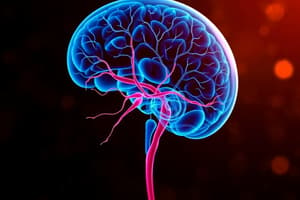Podcast
Questions and Answers
El sistema sensorial somático detecta la luz y el color.
El sistema sensorial somático detecta la luz y el color.
False (B)
El sistema sensorial gustatorio permite oler.
El sistema sensorial gustatorio permite oler.
False (B)
Los receptoras sensoriales son células especializadas que detectan estímulos específicos.
Los receptoras sensoriales son células especializadas que detectan estímulos específicos.
True (A)
Los neuronas aferentes transmiten información sensorial desde el sistema nervioso central (SNC) hacia los receptores sensoriales.
Los neuronas aferentes transmiten información sensorial desde el sistema nervioso central (SNC) hacia los receptores sensoriales.
El sistema visual detecta las ondas sonoras.
El sistema visual detecta las ondas sonoras.
El sistema olfatorio detecta las propiedades químicas de los alimentos.
El sistema olfatorio detecta las propiedades químicas de los alimentos.
Los neuronas eferentes transmiten información sensorial desde los receptores sensoriales hacia el SNC.
Los neuronas eferentes transmiten información sensorial desde los receptores sensoriales hacia el SNC.
El sistema nervioso central (SNC) interpreta y procesa la información sensorial.
El sistema nervioso central (SNC) interpreta y procesa la información sensorial.
Los órganos sensoriales contienen receptores sensoriales especializados.
Los órganos sensoriales contienen receptores sensoriales especializados.
El sistema sensorial vestibular detecta la temperatura.
El sistema sensorial vestibular detecta la temperatura.
Flashcards are hidden until you start studying
Study Notes
Sensory Systems
Sensory systems are responsible for detecting and interpreting internal and external stimuli, allowing us to perceive and respond to our environment.
Types of Sensory Systems
- Somatic Sensory System: detects sensations from the skin and internal organs, such as pain, temperature, touch, and pressure.
- Visual System: detects light and color, allowing us to see.
- Auditory System: detects sound waves, allowing us to hear.
- Vestibular System: detects changes in head position and movement, helping us to maintain balance and posture.
- Olfactory System: detects odor molecules, allowing us to smell.
- Gustatory System: detects chemical properties of food, allowing us to taste.
Pathways of Sensory Information
- Sensory Receptors: specialized cells that detect specific stimuli, such as light, sound, or touch.
- Afferent Neurons: transmit sensory information from receptors to the central nervous system (CNS).
- Sensory Processing: the CNS interprets and processes sensory information, allowing us to perceive and respond to stimuli.
- Efferent Neurons: transmit motor responses to stimuli, such as muscle contractions or gland secretions.
Key Components of Sensory Systems
- Sensory Organs: specialized organs that contain sensory receptors, such as the eyes, ears, and nose.
- Sensory Pathways: the routes by which sensory information is transmitted from receptors to the CNS.
- Brain Regions: specific areas of the brain that process and interpret sensory information, such as the visual cortex or auditory cortex.
Functions of Sensory Systems
- Perception: the ability to interpret and understand sensory information.
- Discrimination: the ability to distinguish between different stimuli.
- Localization: the ability to identify the source of a stimulus.
- Recognition: the ability to identify a stimulus as a specific object or event.
Studying That Suits You
Use AI to generate personalized quizzes and flashcards to suit your learning preferences.




